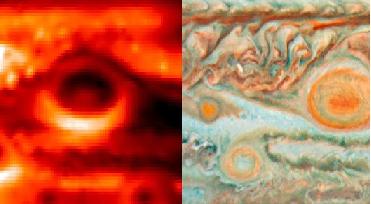
The Great Red Spot of Jupiter. An ESO Photo
PARIS (BNS): The Great Red Spot of Jupiter – an anticyclonic storm – that has enticed astronomers and sky gazers since long, has been viewed in great detail for the first time.
The images of the region, captured by European Southern Observatory's Very Large Telescope and other powerful ground-based telescopes, show swirls of warmer air and cooler regions, enabling scientists to make the first detailed interior weather map of the giant storm system linking its temperature, winds, pressure and composition with its colour, ESO said.
“This is our first detailed look inside the biggest storm of the Solar System. We once thought the Great Red Spot was a plain old oval without much structure, but these new results show that it is, in fact, extremely complicated,” said Glenn Orton, who led the team of astronomers that made the study.
The reddest colour of the Great Red Spot, which is the Solar System's best-known storm system, corresponds to a warm core within the otherwise cold storm system. The images show dark lanes at the edge of the storm where gases are descending into deeper regions of the planet.
The latest observations show how the storm is incredibly stable despite turbulence, upheavals and close encounters with other anticyclones that affect the edge of the storm system. The images enable scientists to map the temperature, aerosols and ammonia within and surrounding the storm.
The Great Red Spot in the giant planet, which can be seen via ground-based telescopes, has lasted for hundreds of years. The spot, which has a temperature averaging about -160 degrees Celsius, is so wide that about three Earths could fit inside its boundaries.
“One of the most intriguing findings shows the most intense orange-red central part of the spot is about 3 to 4 degrees warmer than the environment around it,” said lead author of the findings, Leigh Fletcher.
“This is the first time we can say that there’s an intimate link between environmental conditions – temperature, winds, pressure and composition – and the actual colour of the Great Red Spot,” Fletcher said. “Although we can speculate, we still don’t know for sure which chemicals or processes are causing that deep red colour, but we do know now that it is related to changes in the environmental conditions right in the heart of the storm.”
The findings appear in the journal Icarus.
 Previous Article
Previous Article













The Indian Air Force, in its flight trials evaluation report submitted before the Defence Ministry l..
view articleAn insight into the Medium Multi-Role Combat Aircraft competition...
view articleSky enthusiasts can now spot the International Space Station (ISS) commanded by Indian-American astr..
view article